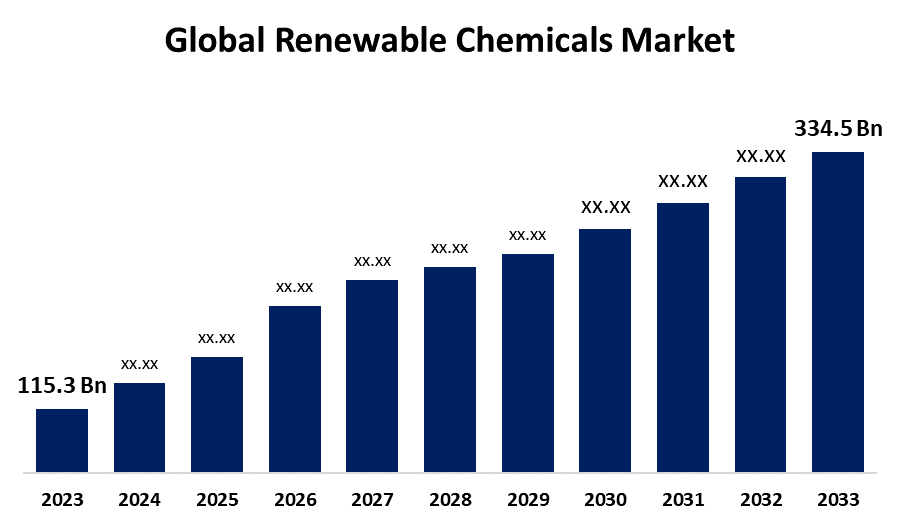Global Renewable Chemicals Market Size, Share, and COVID-19 Impact Analysis, By Type (Alcohols, Organic Acids, Ketones, Biopolymers, and Others), By Application (Transportation, Textiles, Petrochemicals, Packaging, Agriculture, and Others), and By Region (North America, Europe, Asia-Pacific, Latin America, Middle East, and Africa), Analysis and Forecast 2023 - 2033.
Industry: Chemicals & MaterialsGlobal Renewable Chemicals Market Insights Forecasts to 2033
- The Global Renewable Chemicals Market Size Was Valued at USD 115.3 Billion in 2023
- The Market Size is Growing at a CAGR of 11.24% from 2023 to 2033
- The Worldwide Renewable Chemicals Size is Expected to Reach USD 334.5 Billion by 2033
- Latin America is expected to Grow the fastest during the forecast period.

Get more details on this report -
The Global Renewable Chemicals Market Size is Anticipated to Exceed USD 334.5 Billion by 2033, Growing at a CAGR of 11.24% from 2023 to 2033.
Market Overview:
Renewable chemicals are derived from biomass sources such as garbage, plants, and algae. They can provision supportable development, reduce reliance on fossil combustibles, and cut greenhouse gas emissions. Sustainable feedstocks like biomass, crop residue, or surplus materials are used to make renewable chemicals. These materials can outgrowth market growth and offer a beneficial organic substitute for conventional petrochemicals. Industries that are transitioning from petrochemicals derived from fossil fuels to renewable chemicals have a significant opportunity to advance sustainability goals that will facilitate market growth. Advances in chemical manufacturing and biotechnology have led to the making of more efficient and cost-effective procedures for the production of renewable chemicals. The usage of bio-based chemicals is being fortified by governments around the world through encouraging policies, which is speeding up market expansion. For instance, the government of India has launched the BioE3 policy which facilitates acceptable and efficient use of biological resources for revolution, scaling-up, and bio-manufacturing of bio-based chemicals. The universal efforts to reduce emission levels and the growing awareness of contamination have a major impact on the growth of the market for renewable chemicals. The market for renewable chemicals is expanding as a result of urbanization, industrialization, and resident expansion.
Report Coverage:
This research report categorizes the market for the global renewable chemicals market based on various segments and regions forecasts revenue growth and analyses trends in each submarket. The report analyses the key growth drivers, opportunities, and challenges influencing the global renewable chemicals market. Recent market developments and competitive strategies such as expansion, product launch, and development, partnership, merger, and acquisition have been included to draw the competitive landscape in the market. The report strategically identifies and profiles the key market players and analyses their core competencies in each sub-segment of the global renewable chemicals market.
Global Renewable Chemicals Market Report Coverage
| Report Coverage | Details |
|---|---|
| Base Year: | 2023 |
| Market Size in 2023: | USD 115.3 Billion |
| Forecast Period: | 2023 - 2033 |
| Forecast Period CAGR 2023 - 2033 : | 11.24% |
| 2033 Value Projection: | USD 334.5 Billion |
| Historical Data for: | 2019 - 2022 |
| No. of Pages: | 220 |
| Tables, Charts & Figures: | 120 |
| Segments covered: | By Type, By Application, By Region |
| Companies covered:: | OCI N.V., Solvay, DSM, Genomatica Inc., Cobalt Technology, LLC., Elevance, Evonik Industries AG, DuPont, Novamont S.p.A., Novozymes, AVERY DENNISON CORPORATION, Mitsui Chemicals Inc, BASF SE, Mitsubishi Chemical Holdings Corporation, DAIKIN, Braskem, and Others |
| Pitfalls & Challenges: | COVID-19 Empact, Challenge, Future, Growth, & Analysis |
Get more details on this report -
Driving Factors:
The market for renewable chemicals is expanding as a result of urbanization, industrialization, and resident expansion. There has been augmented usage of renewable chemicals in the food and beverage, medicinal, and automotive industries. The sector is rising due to the adoption of rules about greenhouse emissions and the amplified tendency of customers toward sustainable results. The number of renewable chemicals is rising significantly as a result of government efforts and stringent restrictions aimed at improving the environment. To promote the development of renewable biochemicals from domestic biomass in the United States, U.S. Senators Pete Ricketts (R-NE) and Sherrod Brown (D-OH) have sponsored bipartisan legislation that would create a tax credit for American enterprises.
Restraining Factors:
The high cost of chemicals relative to traditional chemical polymers and the slow pace of technological advancement. Furthermore, it is anticipated that the complex manufacturing procedure involved in producing products using renewable chemicals will restrict market expansion.
Market Segmentation:
The global renewable chemicals market share is classified into type and application.
- The alcohol segment is expected to hold the highest share of the market during the forecast period.
Based on the type, the global renewable chemicals market is categorized into alcohols, organic acids, ketones, biopolymers, and others. Among these, the alcohol segment is expected to hold the highest share of the market during the forecast period. As a vital feedstock for environmentally friendly manufacturing, alcohol is a major driver of the market for renewable chemicals. Alcohol is a flexible building block for a wide range of environmentally beneficial compounds derived from renewable resources like biomass. The government initiative program for sustainable development has propelled the segment's growth. For instance, in India, the government-sponsored Ethanol Blended Petrol (EBP) Program enables public sector oil marketing companies (OMCs) to sell gasoline blended with ethanol.
- The packaging segment has the biggest share of the market over the estimated timeframe.
Based on the application, the global renewable chemicals market is categorized into transportation, textiles, petrochemicals, packaging, agriculture, and others. Among these, the packaging segment has the biggest share of the market over the estimated timeframe. The world population flare-up, growing suburbanization, and customers' mounting preference for eco-friendly packaging are the key factors driving this category. The need for renewable chemicals in the packaging sector is being pushed by several causes, including customers' more sustainable lifestyles, amplified concerns about packaging waste, and the development of supportable packaging solutions by major market participants drive the market growth. The packaging industry's need for renewable chemicals is being driven by factors such as customers' enlightening lifestyles, growing worries about packaging waste, and the overview of sustainable packaging solutions by significant players in the market.
Regional Segment Analysis of the Global Renewable Chemicals Market
- North America (U.S., Canada, Mexico)
- Europe (Germany, France, U.K., Italy, Spain, Rest of Europe)
- Asia-Pacific (China, Japan, India, Rest of APAC)
- South America (Brazil and the Rest of South America)
- The Middle East and Africa (UAE, South Africa, Rest of MEA)
Asia-Pacific is projected to hold the largest share of the global renewable chemicals market over the forecast period.

Get more details on this report -
The governments in the area are encouraging the manufacture of environmentally friendly products and chemicals due to the growing concern for the environment. This is driving up product demand, which in turn is fueling the expansion of the Asia Pacific market. China is the country with the quickest growth rate and the largest market share in this region. China's growing chemical industry, rising production of bio-polymers, and higher R&D expenditures are the main factors driving the country's need for bio-based chemicals.
Latin America region is expected to fastest CAGR growth during the forecast period. The market expansion is believed to be caused by the growing usage of alcohols such as ethanol and methanol in the solvents industry, which supplies the beverage, cosmetics, and pharmaceutical sectors. Manufacturers' increasing research and development efforts around the region for the development of cost-effective techniques for the production of renewable chemicals are providing a lucrative opportunity for regional growth.
Competitive Analysis:
The report offers the appropriate analysis of the key organizations/companies involved within the global renewable chemicals market along with a comparative evaluation primarily based on their product offering, business overviews, geographic presence, enterprise strategies, segment market share, and SWOT analysis. The report also provides an elaborative analysis focusing on the current news and developments of the companies, which includes product development, innovations, joint ventures, partnerships, mergers & acquisitions, strategic alliances, and others. This allows for the evaluation of the overall competition within the market.
List of Key Companies:
- OCI N.V.
- Solvay
- DSM
- Genomatica Inc.
- Cobalt Technology, LLC.
- Elevance
- Evonik Industries AG
- DuPont
- Novamont S.p.A.
- Novozymes
- AVERY DENNISON CORPORATION
- Mitsui Chemicals Inc
- BASF SE
- Mitsubishi Chemical Holdings Corporation
- DAIKIN
- Braskem
- Others
Key Market Developments:
- In June 2024, INEOS Green Lake was chosen by Trillium Renewable Chemicals to serve as the first demonstration plant in the world for sustainable acrylonitrile production.
- In April 2024, to make chemicals and plastics more sustainable, Neste and Lotte Chemical, a South Korean chemical business, are collaborating. The companies initiate a strategic partnership to substitute non-renewable raw materials with sustainable ones for the production of chemicals and polymers.
Key Target Audience
- Market Players
- Investors
- End-users
- Government Authorities
- Consulting And Research Firm
- Venture capitalists
- Value-Added Resellers (VARs)
Market Segment
This study forecasts revenue at global, regional, and country levels from 2020 to 2033. Spherical Insights has segmented the global renewable chemicals market based on the below-mentioned segments:
Global Renewable Chemicals Market, By Type
- Alcohols
- Organic Acids
- Ketones
- Biopolymers
- Others
Global Renewable Chemicals Market, By Application
- Transportation
- Textiles
- Petrochemicals
- Packaging
- Agriculture
- Others
Global Renewable Chemicals Market, By Regional
- North America
- US
- Canada
- Mexico
- Europe
- Germany
- Uk
- France
- Italy
- Spain
- Russia
- Rest of Europe
- Asia Pacific
- China
- Japan
- India
- South Korea
- Australia
- Rest of Asia Pacific
- South America
- Brazil
- Argentina
- Rest of South America
- Middle East & Africa
- UAE
- Saudi Arabia
- Qatar
- South Africa
- Rest of the Middle East & Africa
Frequently Asked Questions (FAQ)
-
1.What is the CAGR of the global renewable chemicals market over the forecast period?The global renewable chemicals market size is expected to grow from USD 115.3 Billion in 2023 to USD 334.5 Billion by 2033, at a CAGR of 11.24 % during the forecast period 2023-2033.
-
2.Which region is expected to hold the highest share in the global renewable chemicals market?Asia-Pacific is projected to hold the largest share of the global renewable chemicals market over the forecast period.
-
3.Who are the top key players in the renewable chemicals market?OCI N.V, Solvay, DSM, Genomatica Inc, Cobalt Technology, LLC, Elevance, Evonik Industries A, DuPont, Novamont S.p.A, Novozymes, AVERY DENNISON CORPORATION, Mitsui Chemicals Inc, BASF SE, Mitsubishi Chemical Holdings Corporation, DAIKIN, Braskem, and Others.
Need help to buy this report?